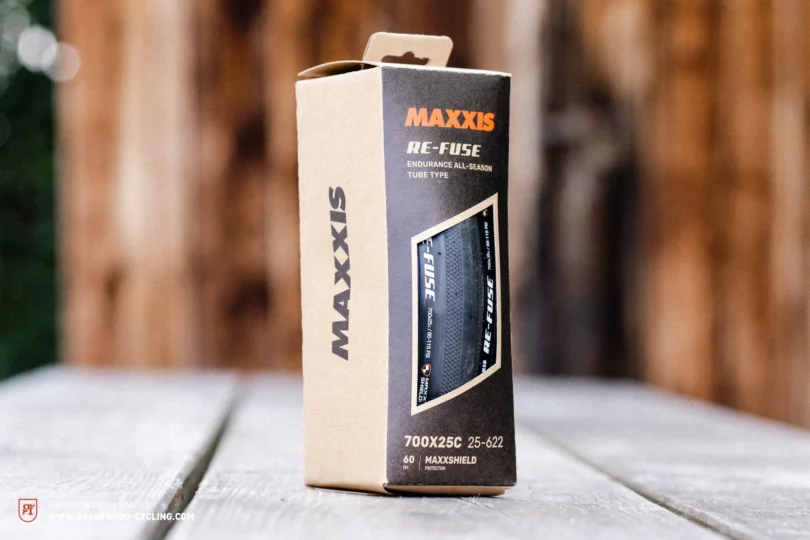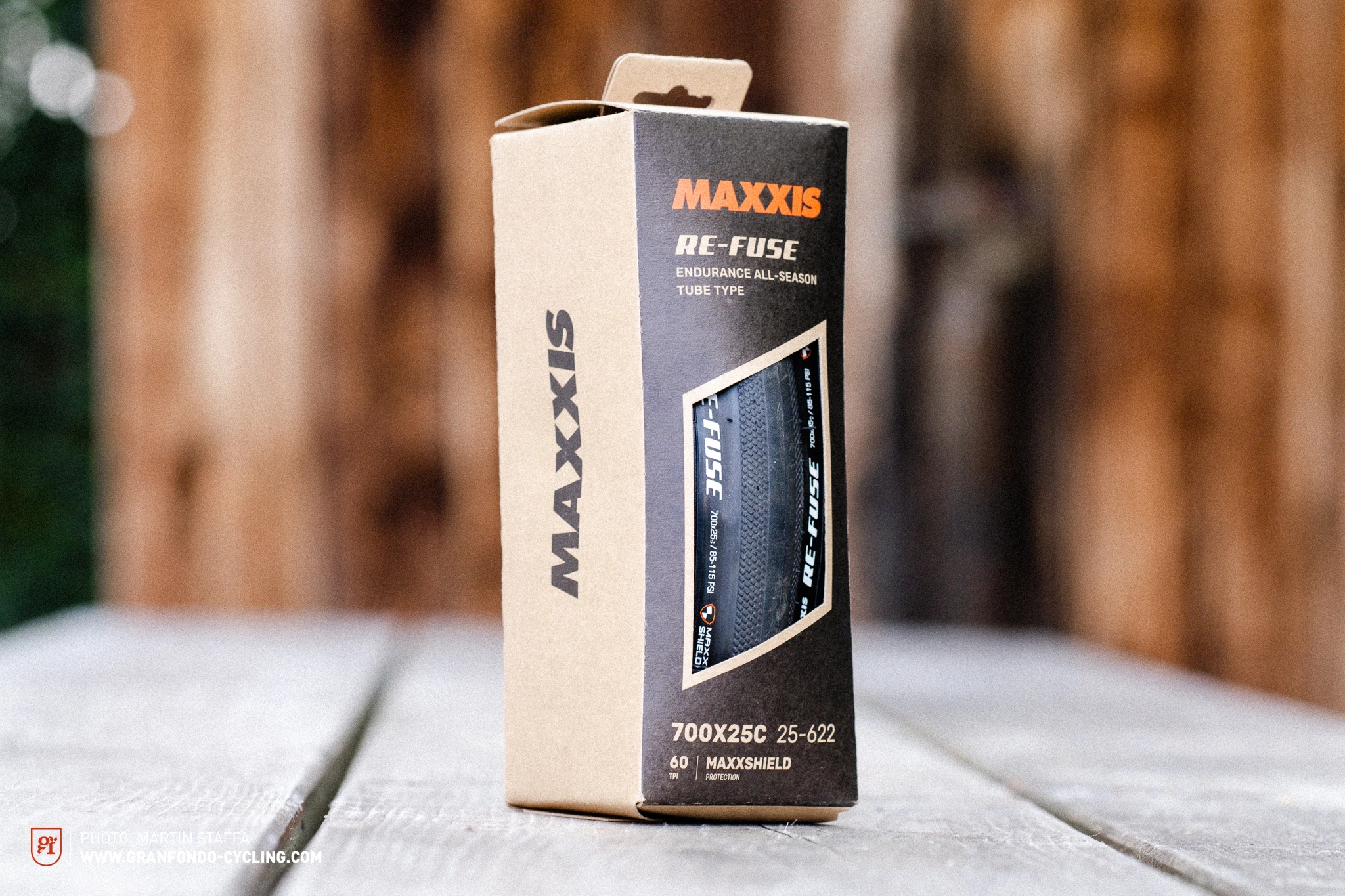First ride review: New MAXXIS Re-Fuse endurance tire – A new all-rounder to last the whole season?

Pretty much a new tire! MAXXIS just revised their popular training and commuting tire from the ground up. The latest iteration of the Re-Fuse features a brand-new tread pattern and revised rubber compound, which are meant to improve both performance and puncture resistance. Does this make it the ideal all-roader for all conditions?

It’s a freezing cold night and you’re pushing through the pain to finish the last few kilometres of a gruelling 200k long-distance race… That’s exactly when you want a robust, puncture proof tire – you’ll take a few watts of extra rolling resistance for the knowledge that you’re going to keep moving. On some days, punctures just aren’t an option. For the upcoming season, MAXXIS went back to the drawing board for their sturdy training tire. The new MAXXIS Re-Fuse is supposed to be lighter, more durable and even more puncture resistant than its predecessor – and of course, to roll faster ! It will be available in several different widths.

MAXXIS Re-Fuse – what’s new and what’s still the same?
The differences between the old and new Re-Fuse are fairly obvious even at first glance. The minimalist tread pattern is now even scarcer, with a raised central band. The light side tread relies on a diamond-knurled pattern, with the small scales converging towards the centre of the tire. This pattern is supposed to ensure optimal rolling characteristics when riding in a straight line while at the same time providing extra traction in corners. The profile looks like it should be fairly solid and robust. MAXXIS has also come up with something new in terms of packaging. It is made from environmentally friendly materials in an eco-design.

Even at first glance, the rubber of the new Re-Fuse looks extremely grippy, almost sticky. This is due to MAXXIS’ new all-season rubber compound, which replaces its predecessor’s dual compound and consists of a “full-silica rubber compound”. This was developed to ensure lower rolling resistance and a longer service life, and at the same time generates excellent traction, especially in wet, slippery conditions. While they were at it, MAXXIS’ engineers revised their proven MaxxShield technology, which is meant to improve puncture protection thanks to its dual-layer consisting of a SilkShield bead-to-bead protection and an additional belt of K2 Aramid Composite under the tread.

With the update, MAXXIS were able to reposition the Re-Fuse in their portfolio and adapt the size options to reflect the updated construction. The previous 700 x 32, 40 mm and 650 x 50 mm options have been replaced with 700 x 25, 28 and 32 mm variants. We’re surprised to see a 25 mm version, given the increasing trend toward wider tires on road bikes, particularly in the endurance and all-road segments. Moreover, MAXXIS no longer classify the Re-Fuse as a training tire, but as an endurance and long-distance, all-weather model with all-road ambitions. As a result, it lines up alongside both the HighRoad model in the performance segment and next to the Pursuer as a training tire. Tan Wall enthusiasts will be left disappointed – MAXXIS only offer the new Re-Fuse with black walls.s. Another surprise is the lack of a TR badge, which means that the Re-Fuse can’t be set up as tubeless. On the other hand, the new Re-Fuse is both lighter and significantly cheaper than its predecessor. Tipping the scales at 338 (32 mm version) the new Re-Fuse is almost 40 g lighter than the old model, which puts it on a par with other comparable all-season tires. Retailing at € 39.90, the new version costs significantly less than its predecessor, which cost € 69.90.

Testing the new MAXXIS Re-Fuse
Throw them on and ride off! The MAXXIS Re-Fuse is super easy to mount, slipping on our 21 mm test rims (inner width) without breaking a sweat, even without tire levers. We combined our Re-Fuse test tires with a TPU inner tube. The tire doesn’t seem to swell or grow once seated on the rim and looks slimmer than the stated 32 mm width. Our callipers confirmed our suspicions, measuring an effective width of 31 mm on the 32 mm version and 27 mm on the 28 mm model. During this test, the optimal air pressure for our rider turned out to be 3.8 bar at the front and 4.0 bar at the rear, which is below MAXXIS’ pressure recommendations (4.5 to 6.8 bar).

We tested the new MAXXIS Re-Fuse in all available widths and over many kilometres. Our test rides included everything from slippery roads to dodgy tarmac and gnarly gravel paths – and despite the abuse, they Re-Fused to puncture! In wet conditions, they generate plenty of traction and inspire huge amounts of confidence, even when carving through corners. In muddy conditions and on deep gravel, the minimalist tread pattern isn’t especially useful, slipping and sliding very easily. On clean surfaces, the MAXXIS Re-Fuse rolls well, literally gliding over the tarmac. However, as soon as you throw a few bumps into the equation, the robust construction makes for a rather uncomfortable ride, forcing you to drop the pressure on rough tarmac or nasty gravel paths. All in all, in terms of riding comfort, the new MAXXIS is no match for less robust tires, like the Conti GP5000.

Our conclusions about the new MAXXIS Re-Fuse
The new MAXXIS Re-Fuse is robust and rolls smoothly, provided you’re riding on smooth surfaces. Its excellent puncture resistance makes it a great choice for situations in which weight isn’t crucial. However, the added puncture protection comes at the expense of riding comfort, which can be improved marginally by running lower pressures. The latest iteration of the MAXXIS Re-Fuse is a great companion for long-distance rides, commutes and winter training, albeit mainly on tarmac. It also strikes a decent balance between price, performance and weigh, making it a very attractive option.
Tops
- Looks and feels robust
- Easy to mount on our test rims
- Discreet look fits all rim- and bike-designs
- Fast rolling and efficient on clean surfaces
Flops
- Relatively low riding comfort
- Unfortunately not tubeless ready
Did you enjoy this article? If so, we would be stoked if you decide to support us with a monthly contribution. By becoming a supporter of GRAN FONDO, you will help secure a sustainable future for high-quality cycling journalism. Click here to learn more.
Words & Photos: Martin Staffa






